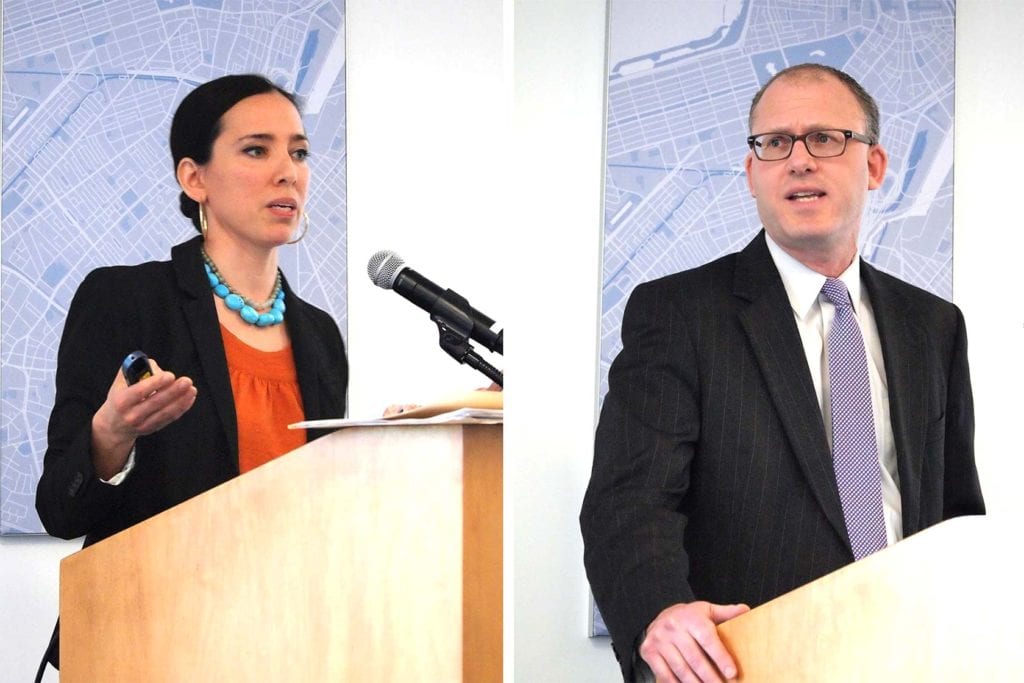Legislators agree on education funding bill
Legislation aims to increase state’s K-12 education budget by $1.5 billion

After months of legislative wrangling, lawmakers introduced an education bill that would add more than $1.5 billion to the state’s outdated Chapter 70 funding formula for local school districts.
Municipal leaders, education activists and representatives of teachers unions expressed support for the Student Opportunity Act, which was announced Sept. 19.
“It is a major and victorious step on the road toward true education funding reform and equity,” said state Sen. Sonia Chang-Diaz, the former co-chair of the Education Committee and a co-sponsor of the Promise Act, an education funding bill from which the Student Opportunity Act drew heavily.
“It contains all of the core criteria we worked hard to include in the Promise Act,” added Promise Act co-sponsor Rep. Mary Keefe.
The Student Opportunity Act, if passed by the Legislature and signed by Gov. Charlie Baker, will phase in funding increases over a seven-year period.
For Boston, the additional state funding could translate into $70 million to $100 million in its $1.3 billion Boston Public Schools budget, according to one city official, who spoke on background. While state funding accounted for 30 percent of Boston’s school budget back in 2001, it has declined to just 4 percent in the fiscal year 2020 budget as charter schools have claimed a larger share of the city’s students and the school funding allocated to them and overall state funding declined.
Although the charter assessments the city pays to the state will also rise, the new bill may lessen the impact with a provision that will fully fund the reimbursements the city pays the state. Under the new formula, the state will reimburse districts for 100 percent of the cost of charter tuition in the first year a student enters a charter, 50 percent in the second year and 40 percent for the third year.
Boston Teachers Union President Jessica Tang said she is cautiously optimistic about the bill’s potential impact on Boston.
“The $1.5 billion increase into public schools is a clear response to years of advocacy from teachers, community members and activists,” she said. “For Boston, it is yet to be seen how much of that funding will go to Boston Public Schools.”
Tang said she would like to see firm guarantees from the state that the charter reimbursements will remain fully funded. For the last six years, the state has not fully funded such reimbursements, despite a state law mandating it.
“In order for this to be a great bill for Boston, we need to get more details and ensure that there are long-term solutions that address the gaps for Boston and other districts,” she said.
Rising costs, lagging funds
The current education funding formula, which was set by the Education Reform Act of 1993, sought to ensure funding parity in school systems across the state. Because cities and towns rely heavily on property taxes for education funding, communities with lower property values often spent thousands fewer dollars per student than did wealthy communities. The Education Reform Act established foundation budgets for municipalities — base funding levels that were aimed at ensuring every district in the state spent enough to give students an adequate education.
While every municipality in the state receives some Chapter 70 funding, cities and towns with low property values and/or large numbers of high-needs students receive supplementary state education funding to satisfy the foundation budget.
Over the years, as employee health care costs and the costs of educating students with special needs and those who are learning English have risen, the state’s Chapter 70 formula has not kept pace. In 2015, the state’s Foundation Budget Review Commission released a report that concluded the state has been underfunding education by between $1 billion and $2 billion. The commission issued recommendations, including that the state adjust its calculation of health insurance inflation separate from general inflation and that it increase weighting for special education students, low-income students and English language learners.
In addition to increased funding, the Student Opportunity Act also includes a provision mandating that districts with student achievement gaps develop three-year plans detailing how they’ll mitigate those gaps. Districts will be required to solicit public input on their plans to close the gaps, and to make the plans public once they’re completed.
Besides increasing funding for English language learners and special education students, the Student Opportunity Act also calls for a $150 million increase in the Massachusetts School Building Authority, which helps districts with the cost of constructing new schools.
House Speaker Robert DeLeo and Senate President Karen Spilka both expressed support for the bill, which must be approved by both chambers before advancing to the governor’s desk.
“The Student Opportunity Act builds on our ongoing efforts to support our neediest students and to close opportunity gaps,” DeLeo said. “The bill includes significant investments, placing a special emphasis on English learners and districts serving high concentrations of low-income students.”
Improvements seen in BPS
In other news, the state’s Department of Elementary and Secondary Education released data on the Massachusetts Comprehensive Assessment System (MCAS) test Monday showing improvement in 67 percent of Boston Public Schools. Additionally, the Nathan Hale Elementary School in Roxbury and the Winship Elementary School in Brighton were among 67 schools in Massachusetts to receive the state’s “School of Recognition” designation for having demonstrated strong growth on academic performance.
The Channing Elementary school in Hyde Park exited turnaround status, a designation the state gives to schools deemed underperforming. The Channing entered turnaround status in 2013.
“The improvements we’re seeing in many of our schools are due to the dedication of our teachers, school staff and community partners who work tirelessly to ensure our students are learning and succeeding,” said BPS Superintendent Brenda Cassellius in a press statement. “I’m proud of their work and look forward to sharing their successes and strategies more broadly across our district.”







